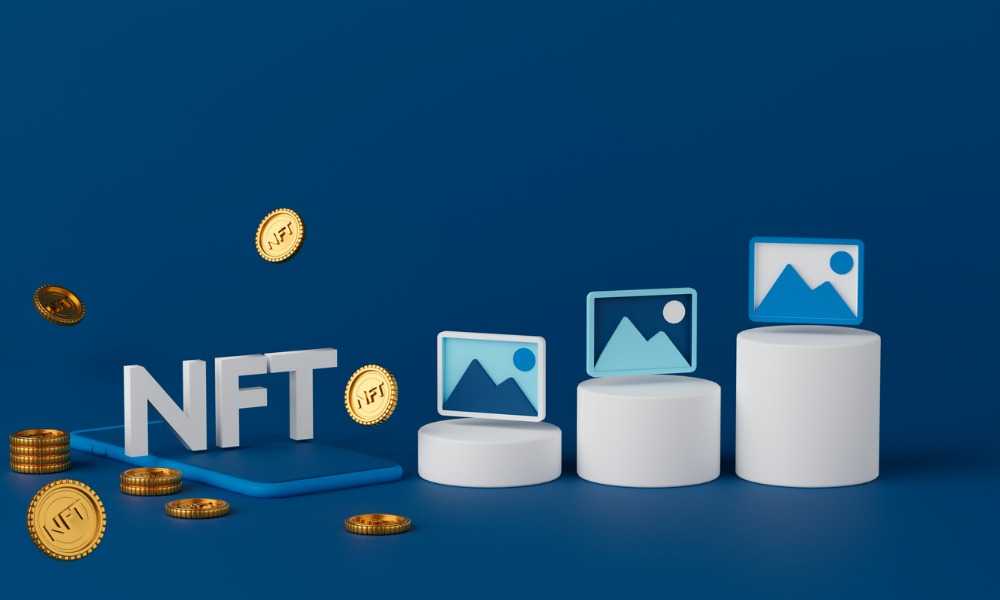While financial services firms and big consumer brands are increasingly on board, so are scammers and other criminals

Creating non-fungible tokens (NFTs) is the newest status symbol for celebrities and brands, but should investors be cautious of the burgeoning digital assets?
Last week, the digital assets were among those listed by KPMG Canada as ripe for expansion along with blockchain and the metaverse, and its first allocations to Bitcoin and Ethereum.
Critics warn that the digital assets are risky and point to similar concerns around cryptocurrencies. But those excited by the market see huge opportunity and often counter criticism by making comparisons to physical fine art, which has long been traded and used as a storage of value.
The first NFT appeared in 2014, but this is still very new for an industry still heavily focused on money markets of several centuries’ heritage. For that reason, we are still in the learning stage of what’s possible.
On the plus side
Those waving the flag for NFTs include Julian Klymochko, founder and CEO of Accelerate Financial Technologies, who recently told Wealth Professional that a boom could be ahead.
“Art has been around for hundreds if not thousands of years as an investable asset class,” he said. “NFTs are digital art or collectibles that exist on the blockchain, and that’s brought about a number of benefits.”
This view is supported by Nigel Green, CEO of international financial advisory firm deVere Group, who believes they will become a mainstay in investment portfolios within the next five years, with three main things attracting investors.
“First, this new digital asset class has value due to the blistering pace of the digitalisation of our world,” he said. “Millennials and Gen Z especially have digital lives and it’s natural to want to take digital representations of, say, luxury brands, music, sport and art into these worlds - and now they can with NFTs.”
Secondly, Green points to NFTs making business models, especially in the creative sectors, more profitable and rewarding.
“Artists and musicians for example can provide enhanced virtual experiences for collectors and buyers, they can prove if their works are counterfeited, and they can include criteria to get royalties every time their works are re-sold in the future.”
Green’s third reason for the investor interest is that “this asset class can act as a major diversifier in investment portfolios,” noting that “NFTs have a very low correlation to other assets, such as stocks and bonds, and can, therefore, lower your portfolio’s overall risk and volatility levels.”
He believes that 2022 will be a breakout year for the digital assets.
Risky assets?
However, there are red flags around the NFT market.
Last year, Coinbase founder Fred Ehrsam said that he believed that 90% of NFTs produced would “probably have little or no value within 3 to 5 years,” drawing comparisons to the dotcom boom/bust of the late 1990s and early 2000s.
The US Internal Revenue Service has also been warning about the potential for fraud and other financial crimes linked to NFTs and cryptocurrencies.
Special agent Ryan Korner said that he is concerned about the high values that investors are placing on digital assets, and that high-profile figures can manipulate the market with a single social media post.
Recently, the Recording Industry Association of America (RIAA) forced a website offline that it accused of infringing music artists’ intellectual property (IP) by selling NFTs that were not authorized.
“Fans were led to believe they were purchasing an NFT genuinely associated with an artist and their work when that was not at all the case,” said RIAA’s Chief Legal Officer Ken Doroshow, calling the use of artists’ album artwork and other IP as “outrageous” and “fraud.”
Money laundering
The US Treasury Department is also concerned and warned earlier this month that “the emerging digital art market, such as the use of non-fungible tokens (NFTs), may present new risks, depending on the structure and market incentives.”
Although it should be noted that this was included in a wider warning about the high-value art market, with both this market and digital assets providing potential conduits for money laundering.



